About hyenas
![]()
Hyenas. Evil, ugly cowards? Not quite. Despite their reputation, hyenas are interesting, intelligent predators. Read and learn.
There are four species of
hyena; The spotted, the brown, the striped and the aardwolf. The spotted hyena
is often known as the laughing hyena.
Typical for hyenas are their long
front legs, their large heads and their mane. The hyenas are very important to
the african eco system - keeping the savannah clean and killing the weak and
sick animals. They do not only scavenge for already killed animals, they are
also good hunters. Their lifestyle is similar to that of many canines, which is
why they look a bit like dogs. Hyenas are, however, more closely related to
cats.
![]()
Spotted hyena (Crocuta crocuta)
The spotted hyena is the most famous (or should I say infamous?) hyena. When people think about hyenas, they usually think of this spotted hunter, also known as the laughing hyena. Actually, the sound is not a laugh (humans are the only animals that laugh) but rather a sign of anger, panic or fear.
The laughing hyena weighs up to 80 kg (about the weigh of a saint bernarnd!) and the female is bigger than the male. This is very important, as the leader of a hyena clan is always a female! One clan can have up to 100 members. This is a society ruled by females - the girls do not only lead the clan, but also choose who to mate with!
The spotted hyena is a sandy
brown colour with darker muzzle, legs and tail. It has dark spots all over its
body. The number and placement of the spots is different from hyena to
hyena. It also varies depending on where the hyena lives.
The hyena also has a mane that goes from the back of its head down to
the back. If the hyena is scared or angry, it will erect its mane to look bigger
and meaner.
When the whelps (puppies) are born, they are pitch black. When the grow older their colour change, and you can see the spots. The whelps are very aggressive and might even kill each other. No body knows for sure, but the hyenas aren't the only animal acting like this. Many eagles kill their siblings when they are young! The mother takes great care of her young and protect them from the males, for they might try to kill the puppies (the same goes for some other animals, lions for example).
Spotted hyenas are known to
live mostly off carrion. This is not entirely true however, for the hyenas are
also great predators. Hyenas get about 80 % of their meals from hunting, while
lions only hunt about 50 % of the time!
The hyenas do not plan their
hunt like wolves, for example. One hyena simply chooses to attack, and the rest
of the clan will come to help it.
Hyenas can, however,
also choose to eat carrion. They can quite easily take a cheetah's kill, and
sometimes a clan of hyenas can even chase a group of lionesses
away!
The hyenas have very powerful jaws. They can crush bones with
their teeth - bones are important to their diet, actually! 15 hyenas can finish
off a zebra in 15 minutes, and then they eat the bones, hooves and fur as well.
What they can't digest, they later throw up in the form of hairballs, just like cats and owls do. The
only part of a carcass that a hyena won't eat are the horns and the
half-digested food in the dead animal's stomach.
Not only
the jaws are specialized for eating - so is the neck and body. The hyena's long
front legs and powerful neck makes it possible for it to carry heavy objects -
such as large pieces of meat - at high speed. Hyenas are very strong and
powerful animals!
After
a meal, the hyena often takes a nice bath. Not to clean up, but rather to help
the hyena digest the food. And for another, perhaps more interesting purpose as
well! When hyenas eat large amounts of food, they get so much energy that the
body temperature rises, and the hyena takes a bath to cool off!
Spotted hyenas are also
intelligent animals, perhaps even smarter than dogs. They have been known to
follow vultures, as they know that the majestic birds will find food sooner or
later. They are very hard to train, and only a few animal trainers work with
them.
Hyenas are very aggressive animals. The female
produce so much male hormons (which makes you more aggressive) that their
genitals look just like the males'. So you actually can't tell a hyena's gender by
looking between its legs! You have to go by other traits, such as size (like I
said, the females are larger!) In past time, it was thought that hyenas were
both male and female, since their genitals look the same!
Hyenas can't be held as pets, no matter how much I know you'd want one ;) They are, like mentioned, very aggressive. Not only that, but they will also heavily mark their territory with urine, and won't hesitate to bite if threatened! The ancient egyptains tried to keep hyenas, but didn't succeed. They did mumify them though!
Below are some more facts about spotted hyenas:
|
![]()
Brown hyena (Hyaena Brunnea)
The second largest hyena is the brown one. This hyena has longer fur than its spotted cousin and a bright peach coloured chest. Its legs are striped, while the rest of its fur is a deep brown. It looks a lot like a dog, perhaps a long-haired german shepherd. Its muzzle is shorter than the spotted hyena's, and it has a better sense of smell. Since it marks its territory with scent marks, smell is very important to it!
The brown hyena is
quite rare and found only in remote desert areas, such as the Kalahari desert.
It rests during the hot day, and looks for food during the freezing desert
night. Its fur protect it, and it can walk up to 50 km in one night, just in
search of food!
Brown hyenas are the largest animals that live
mostly off carrion. It prefers to eat fruits, rather than hunt. If it needs to
hunt, it chooses to look for rodents, hares and small antelopes. The brown hyena
has also learnt to crack open eggs, while the spotted hyena simply stomps on
them!
This desert hyena gets water from eating fruits - in
these areas, fresh water is a luxury, and many brown hyenas rarely get to drink
water at all!
Brown hyenas aren't
as aggressive as the spotted ones, but rather shy. It doesn't make any "laugh",
and is usually quiet.
Usually living alone, but not antisocial: a female, her
whelps and several relatives can live together. The adults greet each other by
taking different poses and nipping at each others' throats, while the pups rub
their noses against each other.
This hyena's social life
isn't as complicated as the other species'. The male and female don't have any
strong bonds between each other and the female usuallly mate with several males
that pass through her territory.
The whelps are born after 90 days of pregnancy. They are usually 2 - 4 in number, blind and deaf until they are about 1 month old. They suckle for three months, and after that, the parents bring them meat. They won't start looking for food on their own before they're about 10 months old. When the female is sexually mature, around the age of 30 months, she can choose between finding her own territory, or raise her pups where she was raised herself. Most males prefer to leave, and walk over large areas in search for a mate.
![]()
Striped hyena (Hyaena Hyaena)
This hyena is not only found in Africa, but parts of Asia, the Middle East, India and southern Russia! It's rare and close to extinction in some areas, however.
Striped hyenas are usually grey or yellow with dark muzzle, legs and tail. Of course, they also have stripes. The mane is usually a darker colour, and goes from the back of the head down all the way to the tail. It's used for communicating as well as scaring others off, by making the hyena look bigger than it really is.
The striped hyena is
usually nocturnal. It lives alone or in small groups of 2 - 3 animals. During
the day, they hide in a cave or thick vegetation. Every striped hyena has a
large territory of up to 40 square kilometres! It marks its home with strong
scent marks.
Very little is known about the striped hyena's social life. No one
knows whether they form couples or just mates with any hyena that happens to
walk by.
The female gives birth to 2 - 4 whelps every
year, usually during a period with much food. In captivity, where food is always
available, the female hyena might have two litters every year.
The whelps are
born with fur, but are blind and deaf. They suckle any available female, not
just their mother. The parents will help each other to bring their young food
until they are old enough to find food on their own.
This hyena isn't
very aggressive, and might even play dead if attacked. It usually prefers not to
fight, even if it means having its food stolen. It's also rather quiet, and can
often pass by without being noticed, something I discovered when meeting the
striped hyenas of Öland's Zoo in Sweden - they didn't make a single sound when they walked
by!
It often looks for food close to villages, and
some villagers find this perfect, since the hyena will happily take care of
their garbage, and they might even make a hole in a wall so that the hyenas can
come in.
But hyenas eat other things as well, in fact, it
will eat pretty much anything. Their body will take even the tiniest bit of
nourishment from whatever the hyena has eaten, and what can't be digested will
later be thrown up, such as hooves and bones.
Some things
that might be on a striped hyena's meny are fruits, such as melons, dates and
peaches (they might even steal from plantations and gardens) as well as some
smaller mammals, birds and insects. They striped hyena also find reptiles
delicious - especially snakes!
Striped hyena
photo album
These hyenas (there are 4 different ones) live in Ölands
Djur- och Nöjespark (a zoo located on an island named Öland, which lays close
to, and belongs to, Sweden). I took these photos 11th of may 2002. A memory for
life ^_^
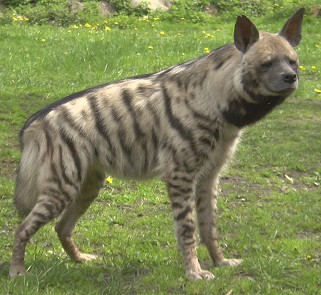
Isn't she a
beauty? How can you hate a creature like this hyena?
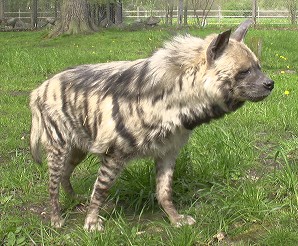
A scruffy old hyena
with a majestic mane and the most intelligent animal eyes I've ever
seen!
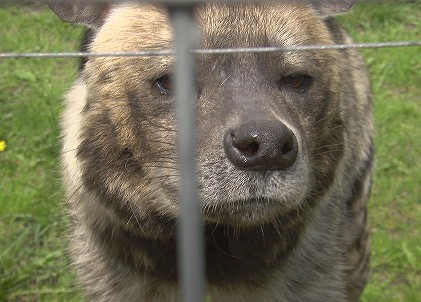
I'm so sorry about
the fence destroying this photo... But look at those eyes! There's true
intelligence there! He (at least I think it was a he...) came forward and to
take a close look at me. I was so happy! I doubt I will ever get as close to a
hyena again! He was standing like 50 cm from me, and we had eye contact!
:D
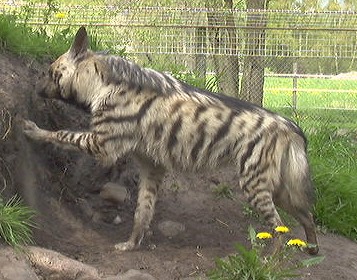
Hyenas like to dig!
This hyena has figured a clever way of escaping the heat of the day! Just look
below :)
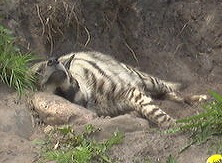
Mm... Sleepy
*yawn* ^_^

You know,
this pose is so "Nellie" (my dog, ya know!) Two of the hyenas slept like this
most of the day (I stayed by them for hours, so I should know *lol* )
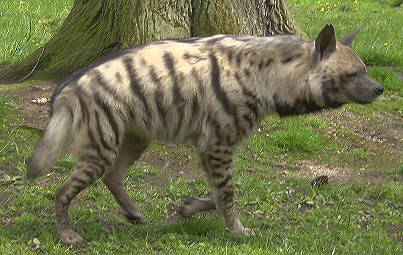
I just can't
get enough of these hyenas :D
![]()
Aardwolf (Proteles Cristatus)
The aardwolf is sometimes not counted as a hyena, but as a one-of-a-kind animal, as it has several differences from other hyenas. For example, it has five foes, while other hyenas have four.
The aardwolf stands at about 40 - 50 cm at the shoulder, with a body length of 50 - 80 cm, and is therefore the smallest hyena. It can be found in eastern and southern Africa. It looks almost exactly like a tiny striped hyena, with light-coloured fur, dark markings and stripes all over its body.
Its name, aardwolf, means earthwolf, and comes from this little creature's love for digging for insects, such as its main food - termites! It has small teeth and weak jaws, but is specialized for these yummy insects! It might also eat carrion. It looks for food during the night, alone or in small groups.
Aardwolves have the typial hyena-mane, and uses it to look far bigger than it really is. If threatened, it may also eject a foul-smelling fluid from it anal glands. Against animals, such as dogs, it uses its canines to protect itself ;)
![]()